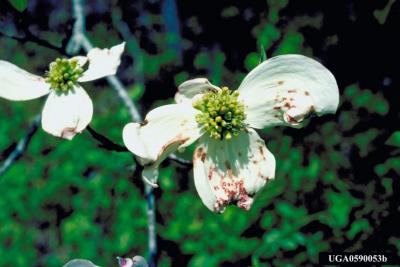
Flowering and Pacific dogwoods (Cornus florida and C. nuttallii) are important components of the forest understory, as well as being valued for their natural beauty. Dogwood fruits are a valuable food source for migratory birds and mammals, and the twigs are browsed by a variety of animals (Mitchell et al., 1988; Rossell et al., 2001). In addition, the species provides habitat for nesting birds, and fallen leaves provide a significant amount of calcium to forest soils (Hepting, 1971).
Both dogwood species are being extirpated from North American forests by non-native fungal disease, dogwood anthracnose. The disease was discovered almost simultaneously in Washington (1976) and New York (1978) (Daughtery & Hibben, 1994). The fungus is particularly virulent in cool, moist conditions, and dogwood populations near water are at the greatest risk. Trees are killed by annual cankers that girdle the trunk. Areas subjected to acid rain may predispose dogwoods to attack and increase the severity of the disease (Anderson et al., 1993). In flowering dogwood, there are surviving trees in populations that have been severely damaged, and natural resistance has been detected (Windham et al., 1998). Still, by 2020, flowering dogwood had declined by more than 80% in piedmont regions of North Carolina. There is now almost no regeneration in most upland sites. No other species has experienced such a precipitous decline (Payne and Peet, 2023). To date, there have been no reports of putative resistant Pacific dogwoods.
USFS scientists and managers developed a conservation priority-setting framework for forest tree species at risk from pest & pathogens and other threats. The Project CAPTURE (Conservation Assessment and Prioritization of Forest Trees Under Risk of Extirpation) uses FIA data and expert opinion to group tree species under threat by non-native pests into vulnerability classes and specify appropriate management and conservation strategies. The scientists prioritized 419 tree species native to the North American continent. The analysis identified 15 taxonomic groups requiring the most immediate conservation intervention because of the tree species’ exposure to an extrinsic threat, their sensitivity to the threat, and their ability to adapt to it. Each of these 15 most vulnerable species, and several additional species, should be the focus of both a comprehensive gene conservation program and a genetic resistance screening and development effort. Dogwood anthracnose disease is not known to be a threat to any of these 15 most vulnerable species.
Sources
Anderson, R. L., P. Berrang, J. Knighten, K. A. Lawton, and K. O. Britten. 1993. Pretreating dogwood seedlings with simulated acidic precipitation increases dogwood anthracnose symptoms in greenhouse-laboratory trials. Can. J. For. Res. 23: 55-58.
Britton, K. O. 1993. Anthracnose infection of dogwood seedlings exposed to natural inoculum in western North Carolina. Plant Dis. 77: 34-37.
Daughtery, M. L., and C. R. Hibben. 1994. Dogwood anthracnose – a new disease threatens 2 native Cornus species. Ann. Rev. Phytopath. 32: 61-73.
Hepting, G. 1971. Disease of forest and shade trees of the United States. United States Department of Agriculture, Forest Service Agricultural Handbook No. 386. 658 pages.
Mitchell, W., P. Gibbs, and C. Martin. 1988. Flowering dogwood (Cornus florida): Section 7.5.9., U.S. Army Corps of Engineers Wildlife Resource Management Manual, Tech. Report EL-88-9, U.S. Army Engineer Waterways Exp. Sta., Vicksburg, MS. 25 pages.
Payne, C.J. and R.K. Peet. 2023. Revisiting the model system for forest succession: Eighty years of resampling Piedmont forests reveals need for an improved suite of indicators of successional change. Ecological Indicators, 154(2023) 110679.
Potter, K.M., Escanferla, M.E., Jetton, R.M., Man, G., Crane, B.S., Prioritizing the conservation needs of US tree spp: Evaluating vulnerability to forest insect and disease threats, Global Ecology and Conservation (2019), doi: https://doi.org/10.1016/
Rossell, I. M., C. R. Rossell, K. J. Hining, and R. L. Anderson. 2001. Impacts of dogwood anthracnose (Discula destructiva Redlin) on the fruits of flowering dogwood (Cornus florida L.): implications for wildlife. Amer. Midland Naturalist 146: 379-387.
United States Department of Agriculture Forest Service, Southern Region, Forest Health Protection. 1999. Southern forest health atlas of insects and diseases. USDA Forest Service, R8-MR 35. 20 pp.
Windham, M. T., E. T. Graham, W. T. Witte, J. L. Knighten, and R. N. Trigiano. 1998. Cornus florida ‘Appalachian Spring’: a white flowering dogwood resistant to dogwood anthracnose. HortSci. 33: 1265-1267.



